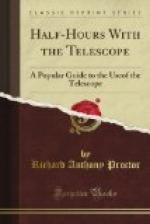In transit the first satellite moves fastest, the fourth slowest, the others in their order. The shadow moves just as fast (appreciably) as the satellite it belongs to. Sometimes the shadow of the satellite may be seen to overtake (apparently) the disc of another. In such a case the shadow does not pass over the disc, but the disc conceals the shadow. This is explained by the fact that the shadow, if visible throughout its length, would be a line reaching slantwise from the satellite it belongs to, and the end of the shadow (that is, the point where it meets the disc) is not the point where the shadow crosses the orbit of any inner satellite. Thus the latter may be interposed between the end of the shadow—the only part of the shadow really visible—and the eye; but the end of the shadow cannot be interposed between the satellite and the eye. If a satellite on the disc were eclipsed by another satellite, the black spot thus formed would be in another place from the black spot on the planet’s body. I mention all this because, simple as the question may seem, I have known careful observers to make mistakes on this subject. A shadow is seen crossing the disc and overtaking, apparently, a satellite in transit. It seems therefore, on a first view, that the shadow will hide the satellite, and observers have even said that they have seen this happen. But they are deceived. It is obvious that if one satellite eclipse another, the shadows of both must occupy the same point on Jupiter’s body. Thus it is the overtaking of one shadow by another on the disc, and not the overtaking of a satellite by a shadow, which determines the occurrence of that as yet unrecorded phenomenon, the eclipse of one satellite by another.[13]
The satellites when far from Jupiter seem to lie in a straight line through his centre. But as a matter of fact they do not in general lie in an exact straight line. If their orbits could be seen as lines of light, they would appear, in general, as very long ellipses. The orbit of the fourth would frequently be seen to be quite clear of Jupiter’s disc, and the orbit of the third might in some very exceptional instances pass just clear of the disc. The satellites move most nearly in a straight line (apparently) when Jupiter comes to opposition in the beginning of February or August, and they appear to depart most from rectilinear motion when opposition occurs in the beginning of May and November. At these epochs the fourth satellite may be seen to pass above and below Jupiter’s disc at a distance equal to about one-sixth of the disc’s radius.
The shadows do not travel in the same apparent paths as the satellites themselves across the disc, but (in an inverting telescope) below from August to January, and above from February to July.




